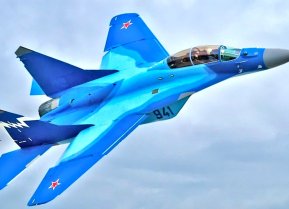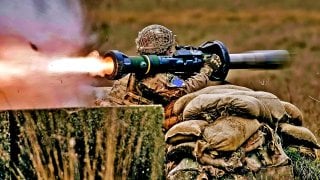NLAW: The Missile That Destroyed Countless Russian Tanks in Ukraine
Analysts have previously estimated that around 30 percent to 40 percent of Russia’s tank losses throughout the war can be attributed to the NLAW specifically.
Meet the NLAW: Recent reports indicate that Ukraine’s counter-offensive may be picking up heat. According to Kyiv, its troops have successfully pushed Russian forces back a few miles from the banks of the Dnipro River and have gained a foothold on “several bridgeheads.”
Ukraine’s army spokeswoman Natalia Gumenyuk told state news channels that "Preliminary figures vary from three to eight kilometers, depending on the specifics, geography, and landscape design of the left bank.” Since Ukraine’s counter-offensive commenced back in early June, its troops have struggled to make any real headway in efforts to recapture territory.
The U.S. and other North Atlantic Treaty Organization (NATO) allies have been frustrated with the lack of progress along the frontlines of the war. In fact, billions of dollars worth of advanced military systems have been delivered to Kyiv by Western nations to help break up the stalemate.
From main battle tanks and airframes to anti-tank weapons and missile systems, Ukraine has received some of the best equipment available across the globe. Arguably the most critical addition to Kyiv’s war arsenal has been the Saab Bofors Dynamics NLAW missile system.
Introducing NLAW
In the early 1990s, Swedish engineers began researching a lightweight anti-tank guided missile for its mechanized infantry.
The formidable fire-and-forget missile system first entered service with the UK, Sweden, and Finland in 2009. Contractor Saab Bofors Dynamics spent nearly a decade developing the weapon, which was designed in a joint venture by the three countries.
However, the name “NLAW” refers to the initial United Kingdom development program for which Saab was awarded the contract.
Like the American-designed FGM-147 Javelin, NLAW is fitted with an onboard guidance system that enables its operator to remain undetected post-launch. Notably, the Javelin is longer range and potentially more lethal than the NLAW.
NLAW is an effective weapon for anti-tank use since its armor-piercing warhead can penetrate heavily protected MBTs. The missile can also be effective at just 20m and is therefore an ideal candidate for short-range operations.
According to manufacturer Saab, NLAW can be used to target a litany of structures, including, armored vehicles and even helicopters. Since NLAW has a shorter range than its American Javelin counterpart, the attributes dictate use in certain conditions.
The weapon weighs under 13 kilograms, making it very easy for soldiers to operate and transport.
Has NLAW Been Effective in Ukraine?
As a line-of-sight weapon, NLAW is guided by direct human targeting using a soft-launch system. This capability has made this missile a critical addition to Ukraine’s war arsenal. Kyiv first received 2,000 NLAW systems from the United Kingdom prior to the outbreak of the invasion in February 2022.

The use of these missiles has proven to be quite formidable for Ukraine’s troops.
In fact, analysts have previously estimated that around 30 percent to 40 percent of Russia’s tank losses throughout the war can be attributed to the NLAW specifically.
Moscow has lost more than half of its main battle tank fleet over the last 600+ days, undoubtedly impacting the Kremlin’s offensive efforts.
Maya Carlin is an analyst with the Center for Security Policy and a former Anna Sobol Levy Fellow at IDC Herzliya in Israel. She has by-lines in many publications, including The National Interest, Jerusalem Post, and Times of Israel. You can follow her on Twitter: @MayaCarlin.


